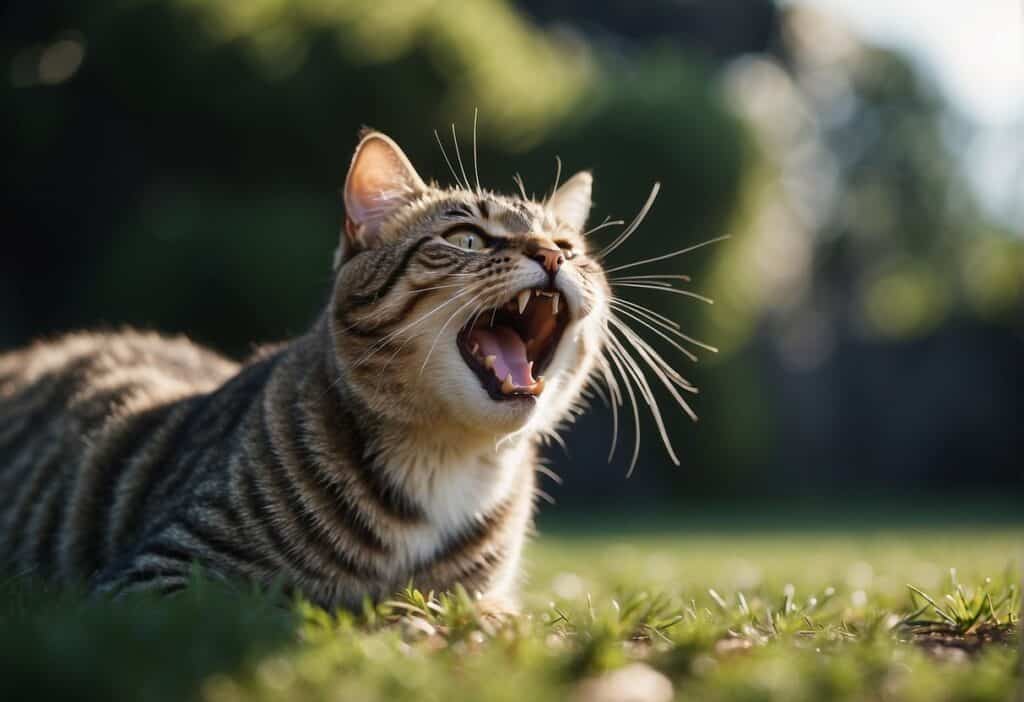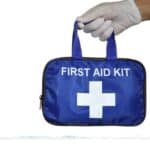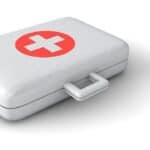The Cat Was Bitten by a Snake: Essential First Aid Steps and Vet Advice

When your cat has an encounter with a snake, it can be a serious and frightening situation. Snake bites can vary in severity, depending on whether the snake was venomous or non-venomous. It’s crucial to recognize the signs of a snake bite and know how to respond promptly to ensure your cat’s wellbeing.
Symptoms of a snake bite in cats may include swelling, visible puncture wounds, pain, and potentially more severe reactions such as weakness, vomiting, or difficulty breathing if the snake was venomous. Immediate veterinary care is essential. Until you are able to reach a professional, keep your cat calm and immobile to help slow the spread of venom.
In any snake bite situation, time is of the essence. Do not attempt to treat the wound yourself or wait for symptoms to worsen before seeking professional help. Contact your veterinarian or an emergency animal clinic right away to get specific instructions based on your cat’s unique situation and the type of snake involved. Your prompt response can make a significant difference in the outcome for your pet.
Recognizing a Snake Bite

When your cat has an encounter with a snake, swift identification and understanding of the bite can be critical to their health and recovery.
Identifying Fang Marks
Upon suspecting a snakebite, examine your cat for fang marks. Nonvenomous snakes may leave a pattern of several small scratches or teeth marks, while venomous snakes often leave two distinct puncture wounds. However, dense fur can obscure bite marks, making them challenging to locate.
Symptoms of Snakebites
Be alert to the following symptoms that could indicate your cat has suffered a snakebite:
- Visible Fang Marks: Look for one or two puncture wounds.
- Pain and Swelling: The bite area may be noticeably painful and swollen.
- Limping: If bitten on a limb, the cat may limp or be reluctant to use the leg.
- Neurological Symptoms: Venomous snake bites can cause drooling, dilated pupils, or seizures due to neurotoxins.
- Systemic Symptoms: Venom can induce shock, which may present as pale gums, rapid heart rate, or weakness.
The severity of symptoms will vary based on the snake species and the amount of venom injected.
Types of Venom
There are two primary types of snake venom that may affect your cat:
- Hemotoxic Venom: This venom damages blood vessels and tissue, and is commonly associated with pit vipers.
- Neurotoxic Venom: Affecting the nervous system, this type of venom can cause paralysis or respiratory failure.
Understanding whether a venomous or nonvenomous snake has bitten your cat informs the urgency and type of medical response needed.
First Aid Measures

When your cat suffers a snakebite, immediate and correct actions can mean the difference between life and death. Understanding what to do and what to avoid is crucial in these critical moments.
Immediate Actions
If you suspect a snakebite, remain calm and approach the situation as follows:
- Identify the bite site and keep your cat still to slow the spread of venom.
- Restrict Movement: Keep your cat’s head and heart level to reduce the circulation of venom.
- Check your cat’s breathing and heart rate to monitor for any distress.
What Not to Do
Be sure to avoid common misconceptions and potentially dangerous mistakes:
- Do not use a tourniquet or tie anything tight around the bite area.
- Do not cut into the bite or attempt suction; this can cause more harm.
- Avoid home remedies and hydrogen peroxide as these are not safe snakebite treatments.
When to Call a Veterinarian
Call your veterinarian immediately if any of the following occurs:
- Signs of shock: such as pale gums, rapid heart rate, or weakness.
- Swelling or pain at the bite site suggests venom injection.
- Change in breathing, lethargy, or collapse, indicating systemic effects.
Seek veterinary attention as soon as possible for potential administration of antivenin and supportive care like pain management and oxygen, if needed. Remember that not all snakebites are venomous, but all should be treated as medical emergencies.
Treatment Procedures
In the event of a snakebite, swift veterinary intervention is imperative to assess the need for antivenom and initiate supportive care to mitigate the toxins’ effects.
At the Veterinarian
Upon arrival, the veterinarian will quickly evaluate your cat’s symptoms to determine the severity of the bite. If the snake is identified as venomous, or if venomous snakebites are suspected, your cat will be closely monitored for signs of systemic effects, such as tissue death or allergic reactions. Veterinary assistance during emergencies like this is crucial and can be lifesaving.
Antivenom Administration
If the bite is from a venomous snake, such as rattlesnakes, pit vipers, or coral snakes, your veterinarian may administer antivenom. This potent treatment is specifically designed to neutralize the venom. Antivenom must be given as soon as possible to be effective, and the veterinarian will be prepared to manage potential allergic reactions to the injection.
- Dosage: Antivenom dosage varies based on the severity of symptoms and the amount of venom injected.
- Purpose: Its goal is to halt further damage by the venom toxins.
Supportive Care
Supportive care forms the backbone of treating snakebites in cats, whether from venomous or non-venomous snakes. This can include:
- IV Fluids: To maintain blood pressure and support kidney function.
- Oxygen Supplementation: Helps in cases where breathing is compromised.
- Medications: Used to control pain, treat bleeding, and reduce swelling.
Immediate and thorough veterinary care is paramount to help ensure your cat’s recovery after a snakebite.
Recovery and Monitoring
After your cat has been treated for a snake bite, close monitoring during recovery is crucial. The severity of the bite—whether from a venomous snake or not—determines the specific care and precautions you need to take.
Post-Treatment Observations
- Monitor Pain and Swelling: Regularly check the bite area for any changes in pain levels or swelling. Your vet might prescribe pain medication or steroids to manage these symptoms.
- Watch for Paralysis or Rapid Breathing: Snake venom, particularly from neurotoxic or cytotoxic snakes, can cause paralysis or rapid breathing. If these symptoms appear or persist, it is necessary to contact your veterinarian immediately.
- Check for Signs of Infection: Even non-venomous snake bites can lead to infection. Administer antibiotics as prescribed and observe the wound for any signs of pus or spreading redness.
Long-Term Care
- Administer Medication as Directed: Consistently give any prescribed steroids or antibiotics to combat inflammation or infection caused by toxins.
- Assess Prognosis: Recovery times can vary, but it is imperative to be patient and follow your vet’s guidance. Prognosis is generally good if prompt and appropriate treatment is provided.
- Prevent Recurrence: Once your cat has recovered, take measures to prevent future snake encounters. Keep your cat indoors or supervise outdoor time, especially in areas where snakes are known to be present.
Prevention and Education
Educating yourself about snake behavior and taking steps to protect your cat can significantly reduce the risk of snakebite incidents. Understanding the habits of snakes and how to safeguard your cat while they’re outdoors are crucial for prevention.
Understanding Snake Behavior
Venomous snakes
- Have elliptical-shaped pupils similar to a cat’s.
- Often equipped with retractable fangs.
- May have rattles on their tails, as with rattlesnakes.
Nonvenomous snakes, which do not have the above features, typically will not pursue or hunt cats as prey. However, if threatened or stepped on, they might bite defensively. Venomous snakes may bite when they feel threatened or while they are hunting for food.
Protecting Your Cat Outdoors
To prevent snakebites:
- Keep your cat indoors during peak snake activity periods, such as dusk and dawn.
- Supervise your cat if they are outside, keeping them away from tall grasses and underbrush where snakes may hide.
- Snake-proof your yard by installing a snake fence: a solid or mesh barrier that goes into the ground to prevent snakes from entering.
- Remove potential snake attractors like food sources (rodents) and shelter (clutter, rocks, logs).
By being aware of these measures and implementing them, you can help keep your cat safe from the dangers of snakebites.
Recognition and Response Planning
When your cat is bitten by a snake, rapid recognition of the bite and a well-devised response plan are critical. Your actions can considerably reduce the severity of the injury and potentially save your pet’s life.
Creating an Emergency Plan
Preparation: Before an emergency occurs, have a plan in place. This includes:
- Identifying your nearest veterinary emergency clinic and keeping their contact information easily accessible.
- Preparing a pet first aid kit that includes basics such as gauze, bandages, and the phone number of the nearest animal poison control center.
Immediate Actions:
- Remain Calm: Your calmness is essential in reducing stress for your cat.
- Limit Movement: Keep your cat still to slow the spread of venom.
- Do Not Attempt Home Remedies: Tourniquets, cutting, or sucking the venom are not advised and can cause harm.
Familiarizing With Local Snake Species
Venomous Snakes Characteristics:
- In North America, venomous snakes like rattlesnakes, cottonmouths, and water moccasins possess heat-sensing pits near the nostrils.
- These snakes typically have elliptical pupils, unlike the round pupils found in non-venomous snakes.
Local Snake Knowledge: Be aware of the snake species in your area – whether they’re venomous or non-venomous:
| Venomousness | Snakes Common in North America |
|---|---|
| Venomous | Rattlesnakes, Cottonmouths, Coral Snakes, Copperheads |
| Non-Venomous | Garter Snakes, Kingsnakes, Rat Snakes |
Allergic Reactions: Remember that besides venom, cats can have allergic reactions to any snake bite. Even non-venomous bites require attention for possible infection or an allergic response.
By understanding your local snake species and having an emergency plan, you’re better prepared for the unfortunate event of a snake bite. Immediate and appropriate action following a snake bite is crucial for the safety and recovery of your pet.







